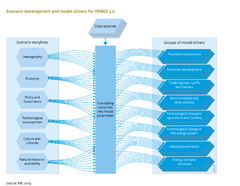Drivers/Scenario drivers: Difference between revisions
< Drivers
Jump to navigation
Jump to search
No edit summary |
No edit summary |
||
| Line 3: | Line 3: | ||
|PageLabel=Scenario drivers | |PageLabel=Scenario drivers | ||
|Sequence=2 | |Sequence=2 | ||
|Reference=PBL, 2010; OECD, 2008; OECD, 2012; UNEP, 2011; PBL, 2011; Chateau et al., 2013; IPCC, 2000; MA, 2005; | |Reference=PBL, 2010; OECD, 2008; OECD, 2012; UNEP, 2011; PBL, 2011; Chateau et al., 2013; IPCC, 2000; MA, 2005; | ||
|Description=When considering how the world might unfold in the longer term, six key scenario drivers are distinguished: demographics, economics, culture and lifestyle, natural resources, technological development and the policy and governance environment. To a large degree these scenario drivers are interdependent, and their future direction is often inferred from a simple to very elaborate ‘storyline’ or narrative. Such storylines describe the type and function of the scenario at hand: a reference projection with no new policies, a single ‘best-guess’ projection combining trends from the past with assumptions about how they might unfold in the future, multiple contrasting scenarios that span a range of uncertainty about the future, or a specific or broad policy scenario aiming to improve future outcomes. For examples, see ([[PBL, 2010]]; [[OECD, 2008]]; [[OECD, 2012]]; [[UNEP, 2011]]; [[PBL, 2011]]) | |Description=When considering how the world might unfold in the longer term, six key scenario drivers are distinguished: demographics, economics, culture and lifestyle, natural resources, technological development and the policy and governance environment. To a large degree these scenario drivers are interdependent, and their future direction is often inferred from a simple to very elaborate ‘storyline’ or narrative. Such storylines describe the type and function of the scenario at hand: a reference projection with no new policies, a single ‘best-guess’ projection combining trends from the past with assumptions about how they might unfold in the future, multiple contrasting scenarios that span a range of uncertainty about the future, or a specific or broad policy scenario aiming to improve future outcomes. For examples, see ([[PBL, 2010]]; [[OECD, 2008]]; [[OECD, 2012]]; [[UNEP, 2011]]; [[PBL, 2011]]) | ||
| Line 35: | Line 35: | ||
==Relations between scenario drivers== | ==Relations between scenario drivers== | ||
As mentioned in the descriptions of the six scenario drivers, assumptions for each tend to depend to a lesser or greater extent on what is assumed for one or several of the other scenario drivers. Plausibility of the set of drivers, over and above the plausibility of each driver in its own right, therefore hinges on a careful consideration of the nature and direction of these relationships. An overarching story or narrative is proven to be helpful in choosing meaningful combinations across each of the six domains ([[IPCC, 2000]]); ([[MA,2005]]). | As mentioned in the descriptions of the six scenario drivers, assumptions for each tend to depend to a lesser or greater extent on what is assumed for one or several of the other scenario drivers. Plausibility of the set of drivers, over and above the plausibility of each driver in its own right, therefore hinges on a careful consideration of the nature and direction of these relationships. An overarching story or narrative is proven to be helpful in choosing meaningful combinations across each of the six domains ([[IPCC, 2000]]); ([[MA, 2005]]). | ||
}} | }} | ||
Revision as of 13:10, 11 December 2013
Parts of Drivers/Scenario drivers
| Projects/Applications |
| Models/Databases |
| Relevant overviews |
| Key publications |
| References |
